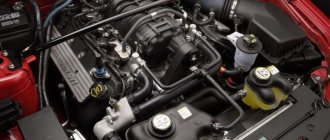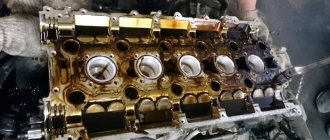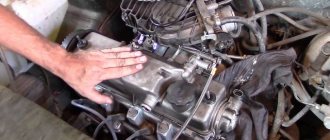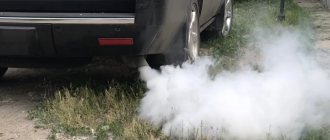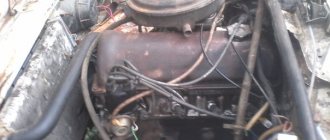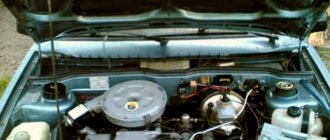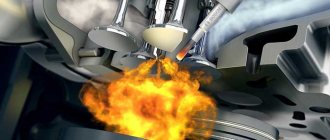string(10) “error stat”
Situation: yesterday your car was driving normally, but in the morning it refuses to start. It would seem that you need to go to a car service center, but how do you actually go? Before calling a tow truck, we’ll try to figure out the problem on the spot.
Why does the engine not start (we take the following situation as a starting point: the battery is in order, the starter rotates vigorously, there is gasoline in the tank).
- There is no power to the spark plug coil (or the spark plugs do not work): unscrew the spark plug, place it on the engine body, turn the starter - there is a spark;
- Gasoline does not flow into the carburetor (we are considering exactly this type of engine; in an injection system everything is much more complicated).
There are not many elements on the path of fuel from the tank to the carburetor; their performance can be easily checked in a garage. This is not so easy to do in a parking lot, unless you “accidentally” have the appropriate set of tools lying around in your trunk.
What is needed to check the fuel supply system to the carburetor?
Let's look at the solution to the problem using the example of the common VAZ 2109 car.
- several screwdrivers (slotted and Phillips);
- set of wrenches;
- car compressor (available in the trunk of a self-respecting driver);
- container (you can use a PET bottle);
- clean rags.
It is advisable to have a fire extinguisher on hand (working, not for technical inspection). Of course, no open flames during work!
Troubleshooting is carried out according to the principle: from simple to complex. Reasons why the supply of gasoline to the carburetor is disrupted:
- Remember the last time the fuel filter was changed. Perhaps it is simply clogged with dirt;
- Water got into the gas line and an ice plug formed (relevant for sub-zero temperatures, “cured” with a mug of hot water);
- Lack of pressure in the fuel line - banal leaks at the joints. Pay attention to whether there is a smell of gasoline around the car after trying to start;
- There is an obstacle in the hose from the gas tank - a piece of rust, a plug of dirt;
- Fuel pump failure;
- Clogged mesh filter near the fitting in the carburetor.
To determine the location of the fault, there are two primitive but effective ways to check:
- Remove the fuel supply rod and press the manual pumping lever several times. If fuel flows, then the pump is working, we continue to search for the cause in the carburetor. The fuel line from the tank to the pump is also in good condition;
- We fill a container with some gasoline, connect it to the fuel supply hose, and place the bottle as high as possible. We try to start the engine. If the engine starts, the reason is in the chain: gas tank, fuel line, filter, pump.
Next, we look for the cause in localized nodes.
Fuel pump testing
The fuel pump, like the air filter, has a manual feed lever. The first check is carried out with its help.
Since the fuel line is already disconnected from the inlet fitting on the carburetor, it can also be disconnected from the fuel pump and purged as a preventive measure. A rag is placed under the outlet fitting of the fuel pump to prevent gasoline from splashing and spreading throughout the engine and engine compartment, and the manual feed lever is pumped several times.
The presence of gasoline at the outlet fitting of the fuel pump will indicate loosening of the pump mounts
. It is necessary to tighten the mounting bolts on the pump housing.
Lack of fuel supply again leaves two options for failure
. The first option is failure of the fuel pump, which is most likely, and the second is a clogged supply line from the gas tank to the pump, which is less likely and rarely occurs.
Based on the above, we can conclude that there are only two truly serious reasons for the fact that fuel does not flow into the carburetor - failure of the fuel pump and a breakdown in the carburetor itself. Other reasons, such as clogged lines or input and output filters, are less likely and less common.
Carburetor check sequence
On the car we tested, the engine air filter is located directly on the carburetor. Therefore, to gain access it must be disassembled.
- Remove the filter cover using a wrench. We take out the filter element (at the same time check its cleanliness) and unscrew the bolts securing the casing to the carburetor. Remove the body;
- Let's look inside the carburetor. Depending on the engine temperature, the throttle valve may be open or closed. In the second case, we open it by hand. Then we press the throttle mechanism drive and check whether a stream of gasoline appears from the pump;
- After making sure that there is gasoline in the carburetor, we get into the car, press the gas, and try to start the engine. If it doesn’t start, look further;
- Remove the top carburetor cover so that the fuel level in the carburetor chamber can be seen. The cover is secured with 5 screws. You should also disconnect the throttle cable bracket and turn off the idle air valve;
- Having released the float chamber, we assess the gasoline level. During normal operation of the fuel supply system, the level should be 23 mm below the walls. You can estimate the level using the tail of a caliper, having previously set it to a depth of 22-23 mm;
- We put the cover back on, fix it with a pair of screws, and start the engine again, having first depressed the gas pedal all the way;
- If the chamber is empty, the verification algorithm is slightly different. We put the lid on, leaving a small gap between the upper edge of the float chamber and the plane of the lid. We fix the gap with a flat steel ruler or a small screwdriver;
- We fill the chamber by manual pumping or by turning the crankshaft a few turns with the starter. After filling the chamber, we try to start again, having first secured the lid;
- The motor starts working - this is a sign of a malfunctioning needle valve. It should be replaced because it is almost impossible to restore it.
A tested and restored carburetor can be assembled, although it would be more correct to dismantle it (since you got to it anyway) and wash all internal parts with acetone.
Signs
If the principles of preparing the fuel mixture in the carburetor towards enrichment are violated, then problems with starting the engine are observed. A hot engine starts especially hard. If the engine does start, the speed is unstable (often increased in idle mode). It is impossible to adjust or somehow stabilize the speed using conventional methods.
If the fuel mixture is too rich, black smoke will come out of the exhaust pipe - the mixture burns directly in the exhaust pipe. When you press the accelerator pedal, failures are possible - the rich mixture burns very poorly. There will be a thick layer of black carbon on the spark plugs.
Sequence of checking the fuel supply system
So, the fault is localized: it is the gas tank-pump-fuel line. The technique is as follows:
- Unscrew the clamp and remove the gasoline supply hose. We lower its end into the prepared container. Important! We strictly observe fire safety measures. The battery cannot be disconnected, since you periodically turn the starter, you should cover it with plywood or plastic so that a key falling on the terminals does not cause sparking;
- We pump up gasoline manually using the fuel pump lever. If there is no fuel, turn the crankshaft 1-2 turns and press the lever again. There is no gasoline - two reasons: either the pump died or the hose is clogged;
- Using the method of elimination, we check the fuel line. We apply pressure to the entrance of the tube using a compressor or a large-volume syringe. Air does not pass through - the hose is clogged. In winter, you can try heating it with boiling water;
- The best option for “treatment” is to remove the line, clean it in any way, rinse with clean gasoline;
- We return the cleaned hose to its place and repeat the experiments with filling the float chamber. If gasoline does not flow, check the fine filter (located immediately after the inlet fitting);
- The mesh must be clean and undamaged. The filter can be washed with acetone;
- It is better to replace a damaged or heavily soiled filter. Its cost is low;
- If after all the procedures gasoline does not flow naturally, the last weak link remains - the gasoline pump. It is difficult to restore it, so it needs to be replaced.
The probability that after all these operations the engine will not start tends to zero. In principle, having a small supply of consumables (this applies to cars with very high mileage), you don’t have to be afraid of being immobilized somewhere on the highway. Failure of the fuel line or carburetor while driving is unlikely; such a malfunction usually appears after parking.
The disadvantages of the carburetor system (primitiveness and mechanical filling) turn into advantages during repairs. A simple tool, a little patience - and your iron horse is back on track. Most often without additional financial costs.
If you have any questions, leave them in the comments below the article. We or our visitors will be happy to answer them
Basics of fuel mixture dosage
The situation when a VAZ carburetor overflows happens especially often. Before examining the reasons, you need to learn a little about the principles of preparing the fuel mixture.
A mixture is considered normal when there are 14.7 parts of air to one part of fuel. All other ratios are a consequence of an incorrectly configured carburetor. If the ratio is from 7 to 1 to 12 to 1, then we can talk about overflow. In this case, difficulties arise in starting the engine. It must be remembered that too rich a mixture, as well as too lean, can be dangerous for the engine. It burns more slowly, which means there is a risk of valve burnout. But the combustion temperature is low.
Screw quality
Most often, the fuel mixture is enriched with a quality screw to compensate for the suction of excess air. This prevents the mixture from becoming too lean. The screw is turned out more than necessary.
You should check the carburetor for possible air leaks and eliminate it. You can check it with a spray bottle. With the engine running, spray on the base of the carburetor, on the connection between the cover and the lower part. If the car starts to stall, then there is an air leak. You can also screw the quality screw back in. But then you can lose stable idle.
Air leak
Often the reason for gasoline not flowing is the junction of the pipes with the fuel pump and carburetor, since air will be sucked in through the leaks, and gasoline will not be pumped.
Air leaks can also occur between the components of the carburetor, as well as at the point where it is attached to the intake manifold. Therefore, when looking for the reason for the engine stopping, you should check the tightness of all fastening nuts and bolts. In some cases, the culprit is a rupture of the gaskets located between the parts of the carburetor, as well as at the point where it is attached to the manifold.
After checking the condition of the gaskets and tightening the fasteners, you can check the functionality of the power system.
Next, we will describe the reasons for interruptions in the supply of gasoline, which usually do not happen on the road, but they should not be ruled out.
For what reasons is fuel not supplied to the cylinders?
So, the general scheme of operation of the power system involves taking fuel from the gas tank, after which the fuel enters the carburetor or injector.
Next, the fuel is supplied to the intake manifold, then the fuel-air mixture enters the combustion chamber through the intake valves.
Common problems with the supply of gasoline to the internal combustion engine
- If we exclude leaks, the next reason why gasoline is not supplied to the engine is various problems with the fuel pump. Note that on cars with a carburetor there is a mechanical type fuel pump and is located in the engine compartment.
The float touches the chamber walls
This is another popular reason. Nail Poroshin, in his numerous videos on setting up carburetors, always shows how to do it. Not everyone watches these videos and when adjusting the floats they do not pay attention to their position relative to the walls in the chamber. If adjusted incorrectly, the float will touch the walls of the chamber, and as a result, overflow.
Check the position of the floats as follows. You need to unscrew the screws on the cover and remove the cover. Then they look at how the floats are located. There is a gasket installed on the lid, and impressions of the walls are visible on it. The floats must be installed in such a way that there is a distance between them and the chamber wall. This can be seen from the print. It is also worth checking whether the float moves easily on the axis.
What does driving with an inoperative engine cylinder lead to?
When a cylinder fails, the fuel mixture entering it does not burn. The fuel is mixed with oil, removing it from the cylinder bore. The mixture will then penetrate into the crankcase. Due to the fact that the surface of the cylinder is dry, scoring occurs on it. In addition, oil mixed with fuel does not lubricate healthy cylinders well.
As a result of the failure of the first cylinder, the others will also stop working normally. Where will all this lead? The car owner will be forced to spend a large sum on boring the cylinder block or even on lining.
The next problem that will happen if the cylinder fails is that the engine will overheat. The change in its operating temperature is due to the fact that the lubricant does not perform its functions. And, as you know, motor oil not only lubricates surfaces, but also removes heat.
All of the above is sufficient reason to declare: under no circumstances should you operate a car after a cylinder failure!
Gaskets
Through the cracks in the gaskets, due to the vacuum, fuel can be sucked in, thereby greatly enriching the combustible mixture. It is necessary to carefully visually check the condition of the gaskets and replace if necessary.
The gasket between the bottom of the carburetor and the manifold may also be worn out. On Ozones, experts recommend checking the gaskets between the housing and the throttle valves.
Why does the engine stall?
The engine shakes, the speed is unstable, especially at idle - these are the consequences of a cylinder failure.
Why exactly? The most common engines were and remain four-cylinder ones, therefore, when one of the cylinders is turned off, the engine has to work on the remaining three, hence the “troit”.
What happens to engines that have more cylinders? There is another opinion here - it’s not because there are three cylinders left to work, but because there are four strokes in an internal combustion engine - intake, compression, power stroke and exhaust - and when one of them turns off - the power stroke, because on the other strokes it does not affect, then three bars remain, hence the triple. Moreover, not only one cylinder can be switched off, but almost all at once in turn. This is also the correct version, but not everyone understands it.
Consequences of a non-functioning cylinder
Even when the cylinder is not working, fuel continues to flow into it, but as a rule it does not burn. Gasoline is a good solvent and washes away the entire oil film from the cylinder walls, hence increased wear of the rubbing surfaces - the piston, rings and cylinder. The gasoline that does not escape into the pipe safely flows into the engine sump, eventually diluting the oil.
Without oil, the pistons move dry, which causes more friction, as well as all kinds of scuffing. But overheating won’t happen; there’s nothing to burn.
Reasons for turning off the cylinder
In order for the engine to operate normally, it must receive a fuel-air mixture, which at a certain moment is ignited by a spark. Based on this, you need to look for the reason, what is missing for ignition.
This could be a problem with the fuel supply (fuel is not supplied, it is poorly atomized, there is too much gasoline, and therefore cannot burn), there could be problems with the air, for example, the intake manifold is clogged. Problems can also arise in the absence of compression, when valves burn out, rings break, the piston burns out, or the hydraulic compensator simply freezes.
Now let's look at these problems in detail.
No spark
A spark is needed to ignite the fuel-air mixture, and may be absent for several reasons:
- The spark plug is faulty (you can see typical faults of spark plugs)
- high-voltage wire pierces / high resistance / jumped out of place
- inoperative high-voltage ignition coil
- no power to the ignition coil if a system with individual ignition coils is used
- wires are mixed up
- the distributor breaks
- or other electrical problems in the ignition system, there are many ignition systems.
To restore functionality, it is necessary to identify the faulty part and replace it. This is best done by replacement, for example, remove the high-voltage wire from the working cylinder and replace it with the high-voltage wire of the non-working cylinder; if no changes occur, then the problem is not in the wire, we look further.
No fuel
It's a little easier here. On an injection engine, fuel enters through the nozzle, which means that the reasons for the lack of gasoline are connected precisely with it:
- the injector is clogged and does not allow fuel to pass through, or does not spray it, but simply pours
- no power to injector
If you unscrew the spark plugs and turn the engine with the starter, a fuel-air mixture should fly out of the spark plug holes, like small droplets of gasoline. If they do not fly, it means that fuel is not reaching that cylinder and the reason is in the injectors.
Air and compression
To ignite the fuel, air is needed, and even under pressure, otherwise the spark will not break through and ignite it. In order for air to flow, it is necessary to check the air supply system to see if anything is clogged.
There was a case when, when repairing a car, they covered the intake manifold with a rag so that nothing would get into it, when they started to start it, the rag itself didn’t pull out, and it safely completely blocked one of the cylinders, even fuel from the injector was absorbed into it.
Also, air may not flow if the intake valves do not open, for example, if the hydraulic compensator jams. Or if this air comes out due to the same hydraulic valve and a slightly open valve, and the valve may burn out and leak.
The piston may also burn out or the rings may break. In general, you just need to measure the compression, and the reasons associated with compression can be found in the link I gave above.
Another reason could be a broken vacuum brake booster. It is connected to the intake manifold by a tube, and if it is broken, then unaccounted for excess air enters the manifold. This leads to the fact that the air flow meter gives one data, but a completely different amount of air comes in. But this is easy to check; you just need to shut off this air source.
Fuel
If the fuel quality is low, ignition problems may occur and detonation may occur. And most cases of unstable engine operation are related to fuel - you went to a gas station, filled in something incomprehensible, and then think about what happened to the car.
The moment of fuel injection into the manifold (distributed injection system) is absolutely not important; there are systems where fuel is injected by injectors into all cylinders at the same time, so even if you intentionally mix up the wires going to the injectors, it should still work.
Another thing is a diesel engine, here the fuel system supplies fuel and determines the ignition timing, so nothing can be confused in diesel engines, neither the injection timing, nor the injection sequence.
But on diesel engines it happens a little for other reasons - the injector may fail, then one cylinder turns off, or the pump may not be set correctly at the moment of injection, then all cylinders will not work correctly, but this is only for mechanical fuel injection pumps.
The common rail system is more similar to a fuel-injected car, but the most similarities are with direct injection.
But with a diesel engine it is more difficult - there are several systems, each of which works in its own way, and to understand what led to the unstable operation of the engine, you must first of all know which system is installed on the car.
Fill with good fuel, use high-quality spare parts, carry out maintenance on time and you will be happy!
Source: https://kakavto.com/?p=261
